The Pros & Cons of 4 Single & Multi-Touch Attribution Models

Attribution models assign revenue credit for a customer based on the touchpoint(s) that influenced their decision to buy. However, choosing an attribution model that fits your needs can be a challenging task. Organizations evaluating different attribution models will need to consider the level of sophistication they require, the types of down-funnel metrics they need to measure, and how much they are willing to invest in an attribution model.
Striking a balance between each of these factors requires an understanding of what each model has to offer. The debate begins with single-touch vs. multi-touch attribution, but within each of these solutions there are still various models to choose from. For our purposes we're going to focus on the pros and cons of four of the more common models; two of which are single-touch and two multi-touch.
Before diving into each model, let's lay out a scenario in order to illustrate how each form of attribution can be applied to it. Keep this scenario in mind as you read through the attribution models below.
- First Touch - An unknown visitor comes to your blog through organic search
- Lead Generation Touch - This unknown visitor becomes a lead by downloading a top of funnel content offer
- Lead Nurture Touch - The lead downloads a middle of the funnel content offer and becomes an MQL
- Converting Touch - The MQL converts by requesting a. consultation and becomes an opportunity
First Touch Attribution
This model falls under the sphere of single-touch attribution. These types of models assign 100 percent of the revenue credit to a single touch or interaction that a lead comes in contact with during the buyer's journey.
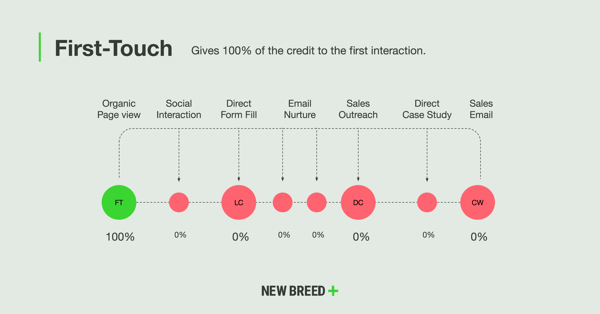
Companies that incorporate first touch attribution subscribe to the belief that the interaction or channel that brought someone to your website is the most important, and should therefore be given all of the revenue credit. Applying this model to the scenario above would attribute organic search with 100 percent of the revenue credit.
Pros
The first-touch model gives marketing insight into which channels and what types of content are driving the most revenue This helps marketing decide where they should invest their top-of-funnel efforts. First touch attribution is more useful for companies that have short sales cycles. Due to its low level of complexity first touch attribution is easy to implement and requires minimal investment.
Cons
Unfortunately, the low level of complexity also means that first touch attribution has some major drawbacks. It ignores the efforts that progressed a lead through the marketing funnel, and therefore provides zero insight into down funnel metrics. This makes it impossible for B2B marketers to make informed decisions on strategy in the middle and bottom of the funnel.
Last Touch Attribution
This model also falls under the sphere of single-touch attribution. Companies that use last touch attribution believe that the interaction that converted a lead into an opportunity are the most important. It's easy to see why, as these touchpoints are the closest to the sales process.
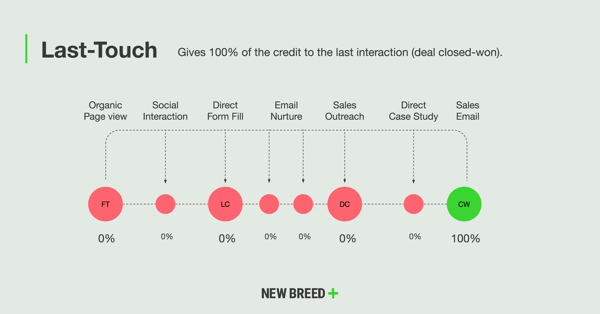
Applying this model to the scenario above would give the consultation request 100 percent of the revenue credit.
Pros
This model is useful for companies that have a wide variety of bottom of the funnel offers or landing pages. It gives insight into the touchpoints that are converting the most leads and how they can be optimized. Last touch attribution is also easy to implement and requires minimal investment.
Cons
Last touch attribution ignores all of the interactions that may have convinced a lead to request a consultation in the first place. This means that marketing would not have any insight into which channel is generating the most revenue. Organizations utilizing this approach are increasing the probability of wasting their marketing efforts on lead generation strategies that are less effective.
Linear Multi-Touch Attribution
Rather than assigning 100 percent of the revenue credit to a single interaction, multi-touch attribution uses weighted modeling to distribute the credit across all forms interactions that progress a lead through the marketing funnel.
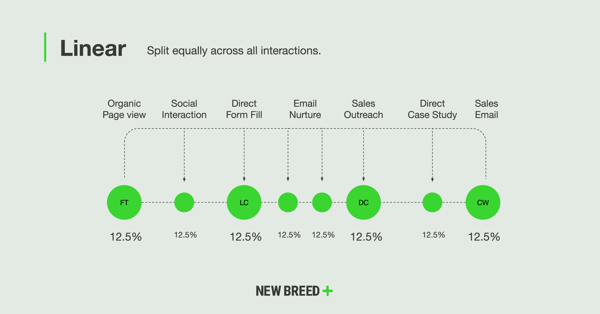
In the case of the linear attribution model, the revenue credit is spread evenly between each touchpoint along the buyer's journey. When we apply this model to the scenario above, the revenue credit would be divided between four interactions (First, Lead Generation, Nurture, & Converting), meaning each would receive 25 percent of the credit.
Pros
Linear attribution, and multi-touch attribution in general, collects additional data on leads when compared to single-touch models, especially in the form of down-funnel metrics. Multi-touch models are also recognized as the most effective ways to prove the benefits of B2B marketing. They give marketers a clearer picture of the entire marketing funnel and better inform their strategy.
Cons
While linear attribution improves upon the deficiencies of single-touch attribution, it is still the simplest of the multi-touch models. It does not give additional weight to marketing touches that have a greater impact. For example, many companies consider touches that occur closer to a conversion to be more important and should therefore be weighted more heavily. It is also much more complex than single-touch attribution models making it more difficult and costly to implement.
Time-Decay Multi-Touch Attribution
The time-decay model corrects for the shortcomings of the linear model outlined above. Time-decay assumes that the closer an interaction is to a conversion, the more influence it has.
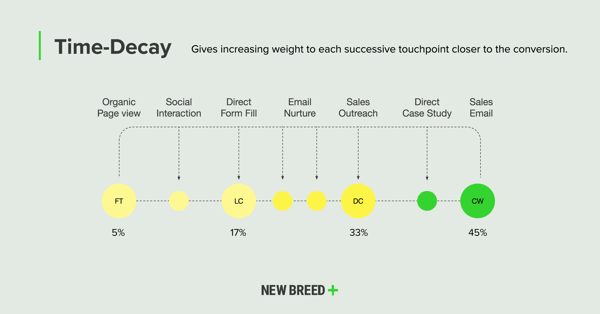
This means that instead of distributing the credit evenly, more weight is given to each successive touchpoint. When we apply this model to our scenario above, 5 percent of the revenue credit would be given to the first interaction, 17 percent to lead generation, 33 percent to nurture, and 45 percent to the converting touch.
Pros
Time-decay attribution, puts a greater emphasis on down funnel conversions. This can be advantageous for B2B companies with sales cycles ranging between 3 to 9 months. It can also help guide the strategy on middle and bottom of the funnel marketing efforts.
Cons
Marketing efforts geared towards the top of the funnel will not be given a considerable amount of credit in the time-decay model. This is due to the fact that top-of-funnel efforts will be furthest from the converting touch. It also adds an extra layer of sophistication to the linear model, increasing the costs of implementation even further.
If the attribution models outlined above do not satisfy the needs of your organization, a quick overview of some more robust multi-touch models is below.
- U-Shaped - This attribution model typically gives around 80 percent of the total weight to the first and last touchpoints. The remaining value is then divided between all other touchpoints.
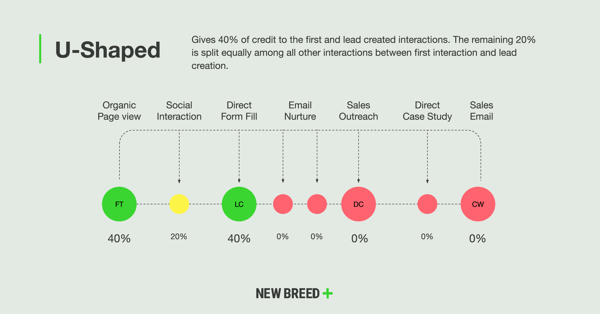
- W-Shaped - This attribution model takes the U-shaped model a step further by giving additional weight to the touch that converts a lead. This results in 90 percent of the weight going to the first, converting, and last touchpoints, with the remaining 10 percent distributed across all other touches.
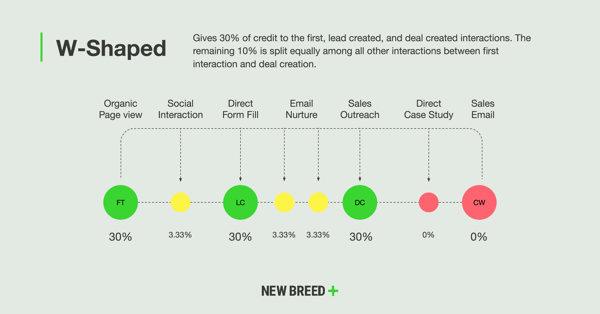
- Full Path - This attribution model takes the three touches of the W-shaped model into consideration, and adds the final touch that results in closing the customer.
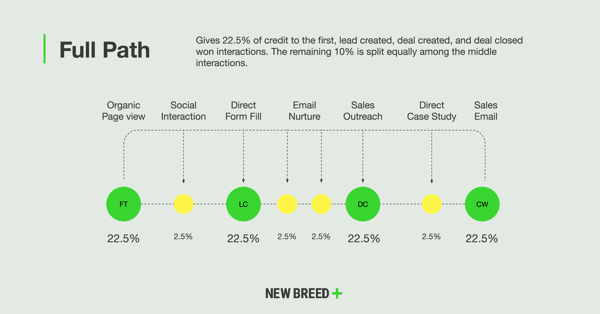
- Custom - This attribution model is for companies that have implemented the type of tracking required for full path-attribution, but want to allocate custom weighting based on their organizational needs.
Choosing an Attribution Model
When it comes to choosing a multi-touch attribution model, there is no clear cut best option. The single-touch attribution model can be effective for companies with short sales cycles and fewer interactions. However, organizations with longer sales cycles, and multiple touchpoints should consider transitioning to a multi-touch model. They provide greater insight into down funnel metrics that can inform your marketing strategies and ultimately drive revenue.
Guido Bartolacci
Guido is Head of Product and Growth Strategy for New Breed. He specializes in running in-depth demand generation programs internally while assisting account managers in running them for our clients.




